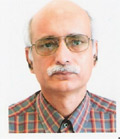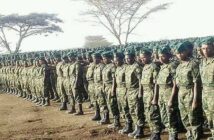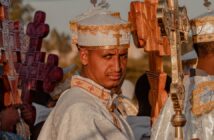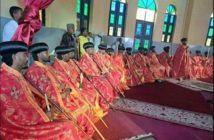Source: Daily Times [Pakistan]
by I Razi Azmi
In the light of the conspicuous pervasiveness of Christianity in Ethiopia, it is somewhat of a surprise to learn that one Ethiopian out of three is a Muslim
The military coup of 1974 that overthrew the famine-stricken Ethiopia’s Emperor Haile Selassie unfolded slowly, just as famines do, after army officers bundled His Majesty out of the royal palace in the back seat of an old two-door VW Beatle and imprisoned him. To these officers with guns, it did not matter that he was not just an emperor, but also “King of Kings, Lord of Lords, Conquering Lion of the Tribe of Judah, Elect of God and Power of the Trinity.”
An internal power struggle amongst the officers lasted nearly five years, which is why observers called it the “creeping coup” and the ‘lazy revolution”. Whatever it was, for the Ethiopian people it heralded a brutal military and one-party dictatorship in the garb of “socialism”.
Soon after seizing power, the regime known as Derg (Committee in Amharic) ordered the execution of 61 former officials of the Imperial government and later of numerous other former nobles and officials including the Patriarch of the Ethiopian Orthodox Church.
In a 1977 shootout, the leader of the coup of 1974, Brigadier Tafari Banti, was himself killed. Subsequently, the vice chairman of the Derg, Lt Col Atnafu Abate, also lost his life along with 40 other officers in this long drawn and bloody power struggle from which Major Mengistu Haile Mariam emerged victorious.
It would take many years, much suffering and up to a million lives, from executions, torture and famine, to rid Ethiopia of the Mengistu dictatorship. In 1991, weakened by an insurgency and the loss of Soviet support, Mengistu Mariam fled to the sanctuary of his good friend in Zimbabwe, another dictator by the name of Robert Mugabe, who clings to power long beyond his “use by” date, causing nothing but suffering to his own people.
The Derg regime’s brutality is recorded in a small but fine museum called the Museum of Red Terror. Quite fittingly, it was inaugurated by a woman whose four children had been executed as “enemies of the revolution”. Very appropriately, too, it is situated next to Meskel Square in the centre of Addis Ababa, where in his heyday Mengistu Mariam took salute as the soldiery marched past to the tune of martial music.
There is not a hint of this in Merkato, Africa’s largest open-air market, only a short distance away. Merkato sprawls over several square kilometres, employs an estimated 13,000 people in over 7,000 businesses. It is quite a place, humming with activity, totally immersed in the present, oblivious to the past and optimistic about the future. Here, buying, selling and haggling over prices occur at a frenetic pace. Being crowded and noisy, it also provides pickpockets with ample business opportunities. As in many Third World countries, there are two sets of prices in Merkato, one for locals and a much higher one for feringhis (foreigners).
The Ethiopians are said to be a very proud people. Two things stand out from my brief visit there and pride is not one of them: these are churches and beggars. Ethiopia is known as a bastion of Orthodox Christianity. Indeed, judging by the abundance of churches and the crowds milling around them, one is left in little doubt that Christianity runs rampant in this wretchedly poor country. Though the crowds comprise of both worshippers and beggars, I hasten to add that all are in fact engaged in begging: the worshippers for God’s favour and the beggars for the worshippers’ generosity!
In the light of the conspicuous pervasiveness of Christianity in Ethiopia, it is somewhat of a surprise to learn that one Ethiopian out of three is a Muslim. Apparently, there is no mutual hostility or animosity between the two communities. The Muslims keep a low profile in exchange for the freedom to live and practice their religion in peace. Harar in eastern Ethiopia is the Muslim ‘capital’ of the country, with 82 mosques, three dating from the 10th century, and 102 shrines. It is the historical centre of Islamic culture and religion in the Horn of Africa.
After the Haile Mariam dictatorship was overthrown, Ethiopia amicably split in two, helped by the fact that the two leaders had been comrades-in-arms in the war of liberation against the Derg regime. When a small northeastern corner of the country became the new, independent state of Eritrea, Ethiopia lost its only access to the sea and became a landlocked country.
The spirit of amity between the two countries, however, did not last long. Within five years of Eritrean independence, a border dispute and clash of egos led to a two-year war between them, resulting in 100,000 deaths and their further impoverishment. With a population of six million, Eritrea was no match for Ethiopia’s 85 million. When the war ended in 2000, Ethiopia occupied nearly a quarter of Eritrean territory. And still does.
Like Ethiopia, Eritrea has two dominant religions, Christianity and Islam, variously estimated at 50 to 62.5 percent and 36.5 to 50 percent of the population, respectively. Both countries have been ruled since 1991 by authoritarian leaders, Meles Zenawi (who died a couple of months ago) and Isaias Afewerki. But while Ethiopia under Zenawi was characterised by impressive economic progress and high international prestige, although criticised for authoritarian rule and lack of freedom, Eritrea under Isaias Afewerki is an internationally isolated, economically depressed dictatorship. Ethiopian elections have been far from fair, but Eritrea has not had any national elections since its founding. Among the numerous political and religious prisoners in Eritrean jails are eight Pakistanis, who had arrived there on a tableeghi jamaat (religious preaching group) mission in 1993.
As a result of economic decline and repression, thousands of Eritreans flee the country every year, some attempting to reach Israel through Sudan and the harsh and treacherous Sinai desert of Egypt. Many fall prey to greedy and heartless Bedouin bandits on the way. Some are cut up for their body parts; others chained and starved for ransom money from their families.
(To be continued)
The writer is a former academic with a doctorate in modern history and can be reached at [email protected].




